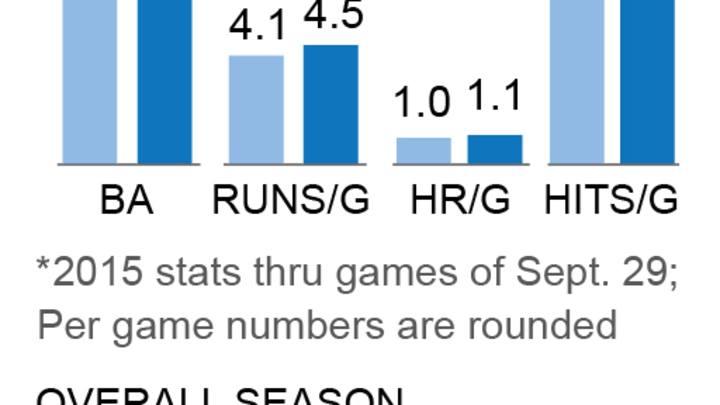After years of declines, MLB offense perks up in 2nd half


NEW YORK (AP) As fresh-faced rookies cleared fences right along with the reliable sluggers into late September, hitters perked up in the second half this season and stopped an eight-year slide in the big league batting average.
The majors' batting average jumped from .253 before the All-Star break to .257. Runs were up, too, and there was a significant spike in homers.
Major League Baseball has been concerned about decreased offense over the past 15 years and has been watching the figures closely.
''Am I glad we had a little more offense? Yes,'' new Commissioner Rob Manfred said. ''But do I think an uptick in August and September of one year is enough to base any decision on? No, I really don't.''
Why the hot second half at the plate?
''Seeing guys for the first time can be a little bit of a disadvantage. You pick up their arm angle a little differently,'' Chicago White Sox outfielder Adam Eaton said. ''When you see them the second time, you have the advantage. And when you see them the third, fourth, fifth time, after the All-Star break, as a hitter, you learn from your mistakes.''
The average number of runs per team each game climbed 9 percent in the second half, from 4.1 to 4.47, and home runs shot up nearly 16 percent, from .95 to 1.1.
Still, the sport is nothing like the homer-happy days of the Steroids Era, an offense boom that saw the batting average peak at .271 in 1999 and the team home run average at 1.17 per game the following year.
The big league batting average was .269 in 2006 but dropped for eight seasons in a row to .251 last year - its lowest since a .244 in 1972, the last season before the American League adopted the designated hitter.
That drop followed the start of drug testing in 2003, penalties for positive steroids tests the following year and a ban on amphetamines in 2006. This season's average is back up to .255.
Average home runs per team each game plateaued at .87 last year, its lowest level since 1992, but perked up to 1.01 this season - around the level of 2012.
''You go back and talk about the juiced balls or some of the technology, the bats and so forth, I don't know if that has something to do with it,'' Oakland manager Bob Melvin said. ''But offense is definitely up, - homers are more so.''
Melvin saw plenty of them leave the ballpark against his A's last weekend, when San Francisco rookie Jarrett Parker connected four times in two games, including a grand slam among his three homers in s 14-10 win Saturday.
After explosive growth in defensive shifts in 2014 and 2015, it appears more hitters adjusted this year - laying down a bunt here and there to give opponents second thoughts and occasionally making an effort to drive outside pitches the other way.
One trend hasn't changed: Most teams have an assembly line of relievers coming out of their bullpens in the middle innings at 95 mph and up.
''A lot of guys are throwing hard,'' Giants shortstop Brandon Crawford said. ''It seems like everybody's throwing a cutter now to keep you off the straight fastball.''
Seemingly tied to the increase in an offense is a spike in game times. Baseball made an effort to speed the pace this year, installing clocks to time between-innings breaks and pitching changes, and telling hitters to keep at least one foot in the batter's box in many instances.
The average time of a nine-inning game was 2 hours, 53 minutes before the All-Star break, a drop of 10 minutes from 2014. But it has been 3:00 since the break, down just two minutes. That leaves the overall season average at 2:56, a 6-minute decrease.
''We're basically back to the 2012 game,'' Manfred said. ''To get an improvement in offense while your still shortening the game, if that's the way it turns out, that would be a very positive development.''
---
AP Baseball Writer Janie McCauley contributed to this report.
